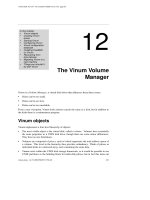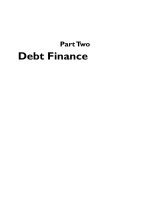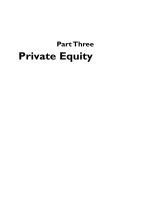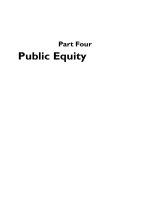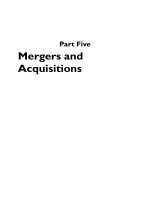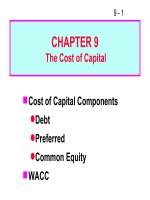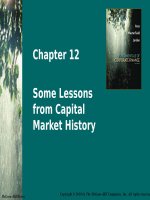Fundamentals of corporate finance brealey chapter 12 the cost of capital
Bạn đang xem bản rút gọn của tài liệu. Xem và tải ngay bản đầy đủ của tài liệu tại đây (83.56 KB, 14 trang )
Solutions to Chapter 12
The Cost of Capital
1.
The yield to maturity on the bonds (since maturity is now 19 years) is the interest
rate that solves the following equation:
90 × annuity factor(r, 19 years) + 1000/(1 + r) 19 = 1050
The solution can be obtained most easily from a financial calculator: Set n = 19,
FV = 1000, PV = (-)1050, PMT = 90. Compute the interest rate as 8.46%. The
after-tax cost of debt is therefore 8.46% × (1 – .30) = 5.92%.
2.
r = DIV/P0 = $4/$40 = .10 = 10%
3.
WACC = × rdebt × (1 – Tc) + × rpreferred + × requity
= .3 × 8.46% × (1 – .30) + .2 × 10% + .5 × 12.5% = 10.03%
4.
r = DIV1/P0 + g = + g = + .05 = .1375 = 13.75%
5.
The total value of the firm is $80 million. The weights for each security class are:
Debt:
Preferred:
Common:
D/V = 20/80 = .250
P/V = 10/80 = .125
E/V = 50/80 = .625
WACC = × rdebt × (1 – Tc) + × rpreferred + × requity
= .25 × 8% × (1 – .35) + .125 × 10% + .625 × 15%
= 11.925%
6.
Executive Fruit should use the WACC of Geothermal, not its own WACC, when
evaluating an investment in geothermal power production. The risk of the project
determines the discount rate, and in this case, Geothermal’s WACC is more
reflective of the risk of the project in question. The proper discount rate, therefore,
is not 12.3%. It is more likely to be 11.4%.
7.
a.
First calculate the company’s WACC
WACC = 30% × (1- 40%)×6% + 70% ×11% = 8.78%
Free cash flow = operating cash flow -investment
12-1
Copyright © 2006 McGraw-Hill Ryerson Limited
= 68 – 30 million
= 38 million
Value of business = 38 /(8.78% - 4%) = 794.98 million
b.
8.
Equity = Value of business - Debt
= 794.98 × (1-30%)
= 556.49 million
The rate on Buildwell’s debt is 5 percent. The cost of equity capital is the required
rate of return on equity, which can be calculated from the CAPM as 4% + .80 ×
8% = 10.4%.
The weighted average cost of capital, with a tax rate of zero, is
WACC
=
× rdebt
+ × requity
= .30 × (1 – 0) × 5% + .70 × 10.4% = 8.78%
9.
IRR, which is 12%, exceeds the cost of capital. Therefore, BCCI should accept the
project. The present value of the project cash flows is
$100,000 × annuity factor(8.78%, 7 years) = $507,032.
Thus the most BCCI should pay for the project is $507,032. If it does, the
project’s NPV will be zero but the project will earn enough to meet the cost of
capital. If BCCI pays $507,032 for the project, then the project’s IRR will be
8.78%, just equal to the cost of capital.
10. The company doesn’t pay tax, so EBITDA is operating cash flow, therefore the
forecasted free cash flows are:
Year
1. EBITDA
2. Investment
3. Free cash flow = 1-2
1
80
12
67
2
100
15
85
3
115
18
97
4
120
20
100
Since free cash flow from year 5 onward will remain unchanged at year-4 levels,
the horizon value at year 4 is:
Horizon value
= (free cash flow at year 5)/ (r –g)
= 100 / (8.78% - 0)
= 1138.85 million
12-2
Copyright © 2006 McGraw-Hill Ryerson Limited
Free cash flow at year 5 $100 million
=
= $1,138.85 million
r-g
0.0878 - 0
The company’s total value is:
PV =
$67
$85
$97
$100
$1138.85
+
+
+
+
= $1,094.53 million
2
3
4
1.0878 (1.0878) (1.0878) (1.0878) (1.0878) 4
Since the capital structure is 30% debt, the value of the firm’s debt is:
0.30× $1,094.53 million = $328.36 million
The value of the equity is:
0.70 × $1,094.53 million = $766.17 million
11.
Security
Market value
Explanation
Debt
Equity
$ 5.5 million
$15.0 million
1.10 × par value of $5 million
$30 per share × 500,000 shares*
Total
$20.5 million
*Number of shares = = 500,000
WACC = × rdebt + × requity
= × (1 – .3) × 9% + × 15% = 12.67%
12.
Because the firm is all-equity financed, asset beta = equity beta = .8. The WACC is
the same as the cost of equity which may be calculated using the CAPM:
requity = rf + β(rm – rf) = 5% + .8 × 10% = 13%
13.
The 12.5% value calculated by the analyst is the current yield of the firm’s
outstanding debt: interest payments/bond value. This calculation neglects the fact
that bonds selling at discounts from or premiums over par value provide expected
returns determined in part by expected price appreciation or depreciation. The
analyst should be using yield to maturity instead of current yield to calculate cost
of debt. [This answer assumes the value of the debt provided is the market value.
If it is the book value, then 12.5% would be the average coupon rate of
outstanding debt, which also would be a poor estimate of the required rate of
return on the firm’s debt. The coupon rate was set when the debt was issued. We
have no idea how long ago the debt was issued. Don’t use the coupon rate as an
estimate of the bond’s required rate of return!]
14.
a.
Using the recent growth rate of 30% and the dividend yield of 2%, one
estimate would be:
12-3
Copyright © 2006 McGraw-Hill Ryerson Limited
DIV1/P0 + g = .02 + .30 = .32 = 32%
In this calculation, we’ve assumed that the current dividend yield is the next
expected dividend divided by the current price, DIV 1/P0. However, if the
dividend yield was the most recent past dividend, DIV0/P0, then with 30%
dividend growth, DIV1/P0 would be .02 × 1.3 = .026 and the estimated
required rate of return would be .026 + .3 = .326, or 32.6%.
Another estimate, based on the CAPM, would be
r = rf + β(rm – rf) = 4% + 1.2 × 8% = 13.6%
15.
b.
The estimate of 32% seems far less reasonable. It is based on an historic
growth rate that is impossible to sustain. No company can grow at 30%
forever. The [DIV1/P0 + g] rule requires that the growth rate of dividends
per share must be viewed as highly stable over the foreseeable future. In
other words, it requires us to use the sustainable growth rate.
a.
The 9% coupon bond has a yield to maturity of 10% and sells for 93.86% of
face value:
n = 10, i = 10%, PMT = 90, FV = 1000, compute PV = $938.55
The market value of the issue is therefore
.9386 × $20 million = $18.77 million
The 10% coupon bond sells for 92.8% of par value, and has a yield to
maturity of 11.0%:
n = 15, PV = (−)928, PMT = 100, FV = 1000, compute i = 11.00%
The market value of the issue is
.928 × $25 million = $23.20 million
The weighted average before-tax cost of debt is therefore
× 10% + × 11% = 10.55%
b.
16.
The after-tax cost of debt is (1 – .30) × 10.55% = 7.39%
The bonds must be selling below par value, because the YTM is greater than the
coupon rate.
12-4
Copyright © 2006 McGraw-Hill Ryerson Limited
The price per $1000 par value is
80 × annuity factor(9%, 10 years) + 1000/1.0910 = $935.82
The total market value of the bonds is
$10 million par value × = $9.36 million
Book value of the preferred shares is $2 million and the par value per share is $20.
Thus there are 100,000 shares of preferred stock (=$2 million/$20 per share).
Preferred shares are selling at $15 per share, for total market value of $1.5 million.
The market value of 1 million common shares selling at $20/share is $20 million.
The book value of the common shares is sum of the common stock plus retained
earnings, which also happens to equal $20 million.
Therefore, the market value capital structure is:
Bonds
Preferred Stock
Common Stock
Total
17.
Dollars
9.36 million
1.50 million
20.00 million
30.86 million
Percent
30.3%
4.9%
64.8%
100.0%
The yield to maturity on debt is r debt = 9%
The rate on preferred stock is rpreferred = $2/$15 = .133 = 13.3%
12-5
Copyright © 2006 McGraw-Hill Ryerson Limited
The rate on common stock is
requity = rf + β(rm – rf) = 4% + 1.5 × 7% = 14.5%
Using the capital structure derived in the previous problem, we can calculate
WACC as:
WACC = × rdebt + × requity + × rpreferred
= .303 × (1 – .4) × 9% + .648 × 14.5% + .049 × 13.3%
= 11.68%
18.
The IRR on the computer project is less than the WACC of firms in the computer
industry. Therefore, the project should be rejected. However, the WACC of the
firm (based on its existing mix of projects) is only 11.68%. If the firm uses this
figure as the hurdle rate, it will incorrectly go ahead with the venture in home
computers. The discount rate for a project is determined by the risk of the project.
University Product's WACC is irrelevant to the analysis of the investment in the
computer project.
19.
a.
r = rf + β(rm – rf) = 4% + 1.5 × 7% = 14.5%
b.
Total market value of Muskoka Real Estate is $6 million and the market value
of the debt is $2 million. Thus the market value of its equity is $6 - $2, or $4
million. The current capital structure is 1/3 debt, 2/3 equity.
Weighted average beta = × 0 + × 1.5 = 1.0
c.
WACC = × rdebt + × requity
= × (1 – .4) × 4% + × 14.5% = 10.47%
d.
If the company wishes to expand its present business then the WACC is a
reasonable estimate of the discount rate since the risk of the proposed project
is similar to the risk of the existing projects. Use a discount rate of 10.47%.
e.
The WACC of optical projects should be based on the risk of those projects.
Using a beta of 1.2, the discount rate for the new venture is
r = 4 + 1.2 × 7 = 12.4%
20.
a.
Equity
Market value = 10 million shares × $15/share = $150 million
rE = rf + rf + β(rm – rf) = 2.5% + 1.2×6.5% = 10.3%
Debt
Market value per bond =
semi-annual coupon payment × PVIFA(6-month r B, no. of payments)
12-6
Copyright © 2006 McGraw-Hill Ryerson Limited
+ face value × PVIF(6-month r B, no. of periods to maturity)
rB = required rate of return on 10-year Gov't debt +150 basis points
Required rate of return on 10-year Gov't debt = (1 + .04/2) 2 - 1 =.0404
rB = .0404 + .0150 = 0.0554 = 5.54%
6-month required rate of return = (1.0554)1/2 - 1 = .0273
Face value = 1000
Coupon payment= .06/2 × 1000 = 30
No. of payments = 2 payments/year × 10 years = 20
Market value per bond
= 30 PVIFA(.0273,20) + 1000 × PVIF(.0273, 20) = $1,041.2
Market value of all bonds = 20,000 bonds × $1,041.2 = $20,824,000
WACC Calculation
Market Value
Market
Weight
Debt
$ 20,824,000
.122
Before-tax
Required
Rate of
Return
5.54%
Equity
Total
$150,000,000
$170,824,000
.878
10.3%
b.
After-tax
Required Rate
of Return
Weight ×
After-tax
Return
(1-.35)×5.54%
= 3.6%
10.3%
.439%
9.043%
9.48%
βU =
To find βdebt , use the CAPM:
rdebt = rf + βdebt (rm – rf)
βdebt = = = .468
βU =
= = 1.14
As expected, the unlevered beta is lower than the levered equity beta. With
no debt in the capital structure, the equity is less risky.
c.
Relever the equity beta to reflect the new capital structure of 50% debt:
βlevered = βU + [βU - βdebt] × D/E × (1 - TC)
= 1.14 + [1.14 - .468] × .5/.5 × (1 - .35) = 1.58
As expected, moving from a debt/equity ratio of .122/.878, or about .139 to .
5/.5, or 1, increases the riskiness of the equity. The levered equity beta
increases from 1.2 to 1.58. The new required rate of return to equity is:
rE = rf + β(rm – rf) = 2.5% + 1.58×6.5% = 12.77%
12-7
Copyright © 2006 McGraw-Hill Ryerson Limited
The new WACC is:
WACC = × rdebt × (1 - TC) + × requity
= .5 × 5.54% (1 - .35) + .5 × 12.77% = 8.19%
21.
a.
NOTE: this question reports two tax rates for Premier Pizza. There should be
only one tax rate. For the purposes of answering this question, the tax rate is
assumed to be 35%.
The annual free cash flows expected from Premier Pizza are:
Calculation of
Annual Cash Flow
1. Revenues
2. Operating costs
3. EBITDA (=1-2)
4. Depreciation
5. EBIT (=3-4)
6. Tax at 35%
7. Profit after tax (=5 – 6)
8. Operating cash flow (= 4 + 7)
9.Capital expenditures
10. Free cash flow (=8 - 9)
.7 × 10 million =
.05 ×10 million =
.35×$2.5 million=
.05×$10 million=
Annual Cash
Flow
$10 million
$ 7.0 million
$ 3.0
$ 0.5 million
$ 2.5 million
$ 0.875 million
$ 1.625 million
$ 2.125 million
$ 0.5 million
$ 1.625 million
The annual cash flows from Premier Pizza are a constant growing perpetuity.
Using the perpetuity formula, the present value of the cash flows is:
PV(annual cash flows) =
annual cash flow
required rate of return - growth rate
Required rate of return on cash flows:
WACC = × rdebt × (1 - TC) + × requity
= .25 × .06 × (1-.35) + .75 × .15 = .12225
PV(annual cash flows) = $1.625 million = $19.76 million
.12225 - .04
If Boris and Isabelle offer $19.76 million for Premier Pizza, the NPV of their
investment will be zero. The offer is the investment in the firm:
NPV = - investment + PV(future firm’s free cash flows)
= -19.76 million + 19.76 million = 0
The project will earn the required rate of return, just enough return to
compensate all investors. This is the maximum amount they should offer. If
they can purchase Premier Pizza for less than $19.76 million, the investment
will earn more than the required rate of return, with the bulk of the extra
return going to the equity investors in the project.
12-8
Copyright © 2006 McGraw-Hill Ryerson Limited
b.
Fresh Foods current WACC
rEQUITY = rf + β(rm – rf) = .03 + .8 × .07 = .086
rDEBT = .05
D/V = .4, E/V = .6
WACC = × rdebt × (1 - TC) + × requity
= .4 × .05 × (1 - .35) + .6 × .086 = .0646
Using Fresh Food's current WACC as the required rate of return on Premier
Pizza gives a valuation of:
PV(annual cash flows) = $1.625 million = $66.06 million
.0646 - .04
This says that Premier Pizza is worth over 3 times more owned by Fresh
Foods than by Boris and Isabelle, even though both groups expect the same
cash flows! The difference comes solely from the different discount rates.
Question: What is the appropriate discount rate for Fresh Foods to use in
valuing Premier Pizza? If you use Fresh Foods' current WACC, you are
assuming that riskiness of the pizza manufacturing business is the same as the
riskiness of the grocery retail business. Why should it necessarily be the
case?
Without further investigation, the better assumption would be that the
appropriate discount rate for Fresh Foods to use for Premier Pizza's cash
flows is 12.225%, the rate used by Boris and Isabella. We know that Boris
and Isabelle investigated the risks of the business before determining the
appropriate discount rate. Under this assumption, the maximum Fresh Foods
should be willing to pay is also $19.76 million.
22.
a. The current promised YTM if there is no default is
YTM = (1000+60-569)/569 = 86.3%
b. If default occurs,
YTM = [.3 × (1000+60) - 569]/569 = -44.1%
c. The current expected YTM is
YTM = probability of default × YTM if default occurs
+ probability of no default × YTM if no default
= .6 × -44.1% + .4× 86.3% = 8.06%
Obviously when the probability of default is high, the promised YTM is too high,
86.3% in this case compared to 8.06% of expected return, so it is not a good
measure of expected return.
12-9
Copyright © 2006 McGraw-Hill Ryerson Limited
23.
If Big Oil does not pay taxes, the after-tax and before-tax costs of debt are
identical. WACC would then become:
WACC = × rdebt + × requity
= .243 × 9% + .757 × 13.5% = 12.41%
If Big Oil issues new equity and uses the proceeds to pay off all of its debt, the
cost of equity will fall. There is no longer any leverage, so the equity becomes
safer and commands a lower risk premium. In fact, with all-equity financing, the
cost of equity would be the same as the firm’s WACC, which is 12.41%, lower
than the previous value of 13.5%. (We use the WACC derived in the absence of
interest tax shields since, for the all-equity firm, there is no interest tax shield.)
24.
The net effect of Big Oil’s transaction is to leave the firm with $200 million more
debt (because of the borrowing) and $200 million less equity (because of the
dividend payout). Total assets and business risk are unaffected. The WACC will
remain unaffected, since business risk is unchanged. However, the cost of equity
will rise. With the now higher leverage, the business risk is spread over a smaller
equity base, so each share is now riskier.
The new financing mix for the firm would be E = 1,000 and D = 585.7. Therefore,
= = .369
and
= = .631.
If the cost of debt is still 9%, then we can solve for the new cost of equity as
follows. We use the fact that, even at the new financing mix, WACC must still be
12.41%.
WACC = × rdebt + × requity
= .369 × 9% + .631 × requity = 12.41%
We solve to find that requity = 14.40%
25.
Even if the WACC were lower when the firm’s tax rate is higher, this does not
imply that the firm would be worth more. The after-tax cash flows that the firm
would generate for its owners also would be lower and this would reduce the
value of the firm, even if those cash flows were discounted at a lower rate. If the
tax authority is collecting more income from the firm, the value of the firm will
fall.
26.
This reasoning is faulty in that it implicitly treats the discount rate for the project
as the cost of debt if the project is debt financed, and as the cost of equity if the
project is equity financed. In fact, if the project poses risk comparable to the risk
of the firm’s other projects, the proper discount rate is the firm’s cost of capital,
12-10
Copyright © 2006 McGraw-Hill Ryerson Limited
which is a weighted average of the costs of both debt and equity.
27. Internet: Calculating WACC of Canadian Companies
Expected results: This question gives students enough information to get a rough
estimate of companies' current WACC.
TD Bank WACC
From Chapter 11, Question 25: 3 month Treasury Bill yield 2.22% as of Oct 2008.
7% market premium.
TD Equity Beta = 1.13
requity = 2.22% + 1.13 × 7% = 10.13%
Using information from yahoo finance and government bond yield, and DBRS,
which gave the debt an AA low rating, the WACC of TD is found to be 6.9%
7 yr gov bond yield = 3.15%
rdebt = 7 yr gov bond yield + AA-rated corporate bond spread = 3.15% +.44% =
3.59%
Equity (billion $)
Debt (billion $)
Firm Value
28.
Market
Weight
Value
28.2
.509
27.23
.491
55.43
1.000
After-tax Cost
.1013
.0359 ×(1-.35)
Component
Cost
.509×.1013
.491×.0359
0.069
Standard & Poor's: Calculate WACC of U.S. Companies
Expected results: Similar to Problem 27, this question gives students the
opportunity to estimate WACC for companies.
a. Hasbro, Inc. engages in the design, manufacture, and marketing of games and
toys. The company principally provides children's and family leisure time and
entertainment products and services. All data is from S&P except where noted
otherwise.
As of December 2008:
Stock price = $29.17/share
Annual dividend per share = $0.80
Dividends have grown at an annual rate of 44.7% over the past 5 years. Not
likely to continue at this rate. Will assume 5% dividend growth rate.
P0 = Div1/(r – g)
requity = Div1/ P0 + g = (1.05)×0.80/29.17 + .05 = 0.0788 or 7.88%
12-11
Copyright © 2006 McGraw-Hill Ryerson Limited
b. As of December 2008:
Equity Beta: 1.218
3-month Treasury Bill rate = .3%
Market risk premium = 7%
requity = .3% + 1.218 × 7% = 8.826%
Market value of equity (“market cap”) = $4,060.464 million
Long Term Debt:
Due In One Year
7.586
Long Term Debt 709.723
Total debt = 7.586 + 709.723 million = $717.309 million
S&P Issuer Credit Rating: BBB
7-year US Gov’t bond yield: 1.87%
(NOTE: historical US gov’t yield from:
/>rdebt = 1.87% + 1.25% = 3.12%
Market Value
Equity (million $)
Debt (million $)
Firm Value
$4,060.464
$717.309
$4,777.773
Weight
.85
.15
1.000
12-12
Copyright © 2006 McGraw-Hill Ryerson Limited
After-tax
Component
Cost
Cost
.08826
.85×.08826
.0312×(1-.35) .15×.02028
0.078
Solution to Minicase for Chapter 12
Bernice needs to explain to her boss, Mr. Brinestone, that appropriate rates of
return for cost of capital calculations are the rates of return that investors can earn on
comparable risk investments in the capital market. Mr. Brinestone’s estimate of the cost
of equity is his target value for the book return on equity; it is not the expected rate of
return that investors demand on shares of stock with the same risk as Sea Shore Salt.
Bernice’s CAPM calculation indicates that the correct value for the equity rate is
10.5%. This value is broadly consistent with the rate one would infer from the constant
growth dividend discount model (which seems appropriate for a mature firm like this
one with stable growth prospects). The dividend discount model implies a cost of equity
of a bit more than 10.5 percent:
requity = + g = + .067 = .117 = 11.7%
This value is close to Bernice's value. It is not surprising that the different methods for
estimating the cost of equity yield different values. However, it is reassuring that the
values are similar. For the rest of the solution we will use 11% as the cost of equity.
Mr. Brinestone’s returns for other securities should be modified to reflect the
expected returns these securities currently offer to investors. The bank loan and bond
issue offer pre-tax rates of 7.75% and 8%, respectively, as in Mr. Brinestone’s memo. It
is acceptable to use the interest rates on the loan and the debt as the required rates of
return given the information provided. We are told the "bank charged interest at the
current rate", which implies that the bank loan rate is a floating rate and hence changes
when market rates change. We are told that the bonds were just issued. The convention
is to set the bond coupon rate at the bond's required rate of return so that the bond will
be sold at par value. The preferred stock, however, is not selling at par, so Mr.
Brinestone’s assertion that the rate of return on preferred is 6% is incorrect. In fact, with
the preferred selling at $70 per share, the rate of return is
rpreferred = = = .086 = 8.6%
This makes sense: the pre-tax return on preferred should exceed that on the firm’s debt.
Finally, the weights used to calculate the WACC should reflect market, not book,
values. These are the prices that investors would pay to acquire the securities. The
market value weights are computed as follows:
12-13
Copyright © 2006 McGraw-Hill Ryerson Limited
Comment
(%)
Bank loan
Bond issue
Pfd. stock
Common stock
valued at face amount
valued at par
$70 × 1 million shares
$40 × 10 million shares
Amount
(millions)
$120
80
70
400
$670
Percent
of total
17.91
11.94
10.45
59.70
100.00
Therefore, the WACC, which serves as the corporate hurdle rate, should be 9%:
WACC = .1791 × 7.75% × (1 – .35) + .1194 × 8% × (1 – .35)
+ .1045 × 8.6% + .5970 × 10.5 = 8.69%
12-14
Copyright © 2006 McGraw-Hill Ryerson Limited
Rate of
return
7.75
8.0
8.6
10.5
